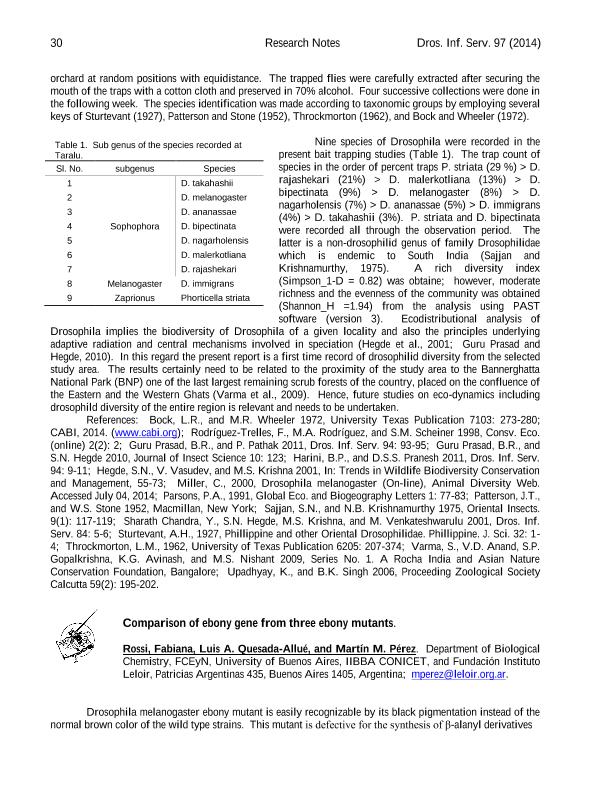Artículo
Comparison of ebony gene from three ebony mutants
Fecha de publicación:
12/2014
Editorial:
University of Oklahoma
Revista:
Drosophila Information Service
ISSN:
0070-7333
Idioma:
Inglés
Tipo de recurso:
Artículo publicado
Clasificación temática:
Resumen
Drosophila melanogaster ebony mutant is easily recognizable by its black pigmentation instead of the normal brown color of the wild type strains. This mutant is defective for the synthesis of β-alanyl derivatives such as N-β-alanyldopamine (NBAD) or N-β-alanylhistamine (carcinine), which are the products of the conjugation of β- alanine with dopamine or histamine respectively. Besides body color defect, other wellknown features of this mutant are the neurological and behavioral disorders, such as abnormal electroretinograms, lacking “on” and “off” transients (Hotta and Benzer, 1969), reduced phototaxis (Benzer, 1967) and abnormal circadian rhythm (Newby and Jackson 1991). For many years, Ebony was known as an epidermal enzyme responsible only for tanning and sclerotization of brown cuticles (Wright, 1987). We previously demonstrated that NBAD-synthase is an enzyme induced in epidermis with a narrow window of expression at the beginning of pupariation (Pérez et al., 2002; Wappner et al., 1996a). The enzyme is also induced during the transition from pharate adult to imago and during the first hours after the ecdysis (Pérez et al, 2004: Pérez et al., 2010). Recently, we documented the expression of NBAD-synthase in epidermal tissues of D. melanogaster embryos (Pérez et al., 2010). In addition to the expression of NBAD-synthase in epidermis, we found that this activity is also expressed constitutively in nervous system (Pérez et al., 2004), suggesting a role in the metabolism of neurotransmitters. Furthermore, it has been postulated that this enzyme functions in a metabolic pathway that may terminate the action of histamine in photoreceptor cells (Borycz et al., 2002; Richardt et al., 2003). Our biochemical and immunohistochemical results demonstrated that NBAD-synthase is widely expressed in the brain. Thus the expression of Ebony in brain regions other than retinas suggests that this enzyme not only plays a role in the metabolism of histamine in visual system but also in the metabolism of other neurotransmitters like dopamine and possibly octopamine and serotonin (Pérez et al., 2002; Richardt et al., 2003; Pérez et al, 2004). We previously analyzed NBAD-synthase in vitro activity in the ebony mutants e1 and e4 and we found that they are unable to synthesize β-alanyderivatives (Pérez et al 1997; 2001). We have also cloned and sequenced the e4 mutant gene, showing that it has a 447 base pairs deletion in its first exon, synthesizing a protein without activity due to the lacking of 149 aminoacids (Pérez et al., 2001). Some slight physiological differences exist among the different ebony mutants, with e4 being the less drastic phenotype (Newby and Jackson, 1991; Rossi et al, data not shown; Flybase). To address the reason of this discrepancy we characterized molecularly e1 and e11 to better understand their phenotypes...
Palabras clave:
Ebony
,
Nbad-Synthase
,
Coding Sequence
,
Alleles
Archivos asociados
Licencia
Identificadores
Colecciones
Articulos(IBIOBA - MPSP)
Articulos de INST. D/INV.EN BIOMED.DE BS AS-CONICET-INST. PARTNER SOCIEDAD MAX PLANCK
Articulos de INST. D/INV.EN BIOMED.DE BS AS-CONICET-INST. PARTNER SOCIEDAD MAX PLANCK
Articulos(IIBBA)
Articulos de INST.DE INVEST.BIOQUIMICAS DE BS.AS(I)
Articulos de INST.DE INVEST.BIOQUIMICAS DE BS.AS(I)
Citación
Pérez, Martín Mariano; Rossi, Fabiana Alejandra; Quesada Allue, Luis Alberto; Comparison of ebony gene from three ebony mutants; University of Oklahoma; Drosophila Information Service; 97; 12-2014; 30-32
Compartir




